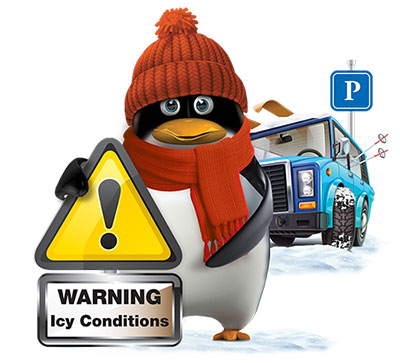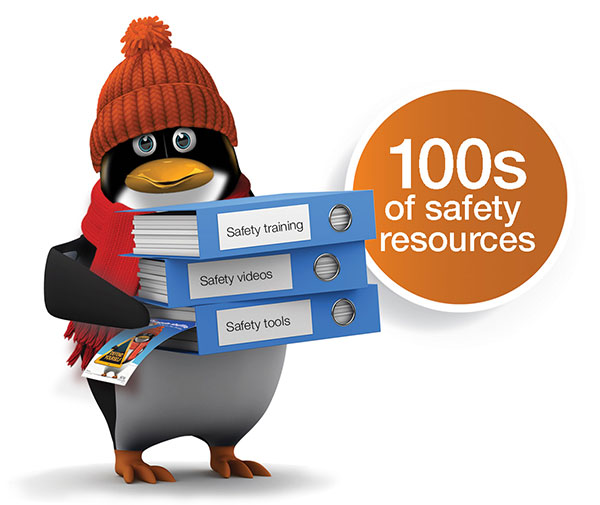Winter slips and falls are a leading cause of work injuries in the Upper Midwest, and one of the most common injuries we see at SFM.
Compelling data highlights the serious impact of slips and falls in the workplace:
- In 2017, the U.S. Bureau of Labor Statistics (BLS) reported 20,000+ occupational injuries related to ice, sleet and snow (doesn’t include falls from heights or through surfaces)
- According to OSHA, slips and falls contribute to 20% of all workplace injuries, costing companies billions in insurance claims, lost hours in liability lawsuits, and 15% of all accidental deaths (second only to motor vehicle accidents)
- The CDC indicated that the medical costs for winter slips and falls topped out at $50 billion in 2015 — more than 800,000 have been hospitalized due to slip and fall injuries (mainly hip and head injuries)
- According to SFM claims data, 25 percent of ice- and snow-related falls occur in parking lots and 20 percent of slips and falls that occur in parking lots result in lost time from work

Workers who sustain injuries from winter slips and falls often take multiple days to recover which results from time off from work. SFM estimates the average winter slip-and-fall lost-time claim to be between $50,000 and $55,000. The costs — direct and indirect — mount quickly and can’t be ignored.
Examples of injury-causing hazards
- Unsecured floor mats that can easily trip people
- Wet mats and/or floors in entrances greatly increase the chances of slipping
- Ice and snow on sidewalks (ice from landscape drainage) create conditions that are ideal for injury-inducing slips and falls
- Uneven curbs and sidewalks from concrete upheaval can cause someone to stumble, trip and fall
- Snow-covered curbs make it hard to see where to walk, which in turn can lead to a misstep, ending in a trip or fall
- Divots, dips and depressions in parking lots all increase the risk of miscalculation, missteps and stumbles
- Snow between vehicles can easily become compacted and icy, creating a hazardous condition
Remind employees about winter hazards using SFM resources
With a little prevention and simple precautions, falls on snow and ice resulting in costly injuries can be easily avoided. Employee awareness is key.
- Do the penguin shuffle: Focus on your footing, walk flat-footed, take short steps to keep your center of balance over your feet
- Take it slow : Walk slow on snow and ice to avoid a slip
- Wear proper footwear for the weather: Choose footwear with non-slip soles, deep treads and wide, low heels; add cleats for extra traction
- Carry only what you can: Carrying less or using a bag or backpack decreases your chance of falling — and keeps your hands free if you do
- Watch for changing conditions: Monitor the weather; cycles of freezing, melting and re-freezing are especially dangerous
- Don't be distracted: Put your cell phone away while walking and focus on where you're going
- Step down, not out, from curbs and cars: Falls in parking lots are common — step flat-footed off curbs, step down with both feet when exiting your vehicle
- Walk on marked paths and avoid short cuts : Short cuts are likely to be icy and put you in danger of slipping
- Report icy conditions : Tell a supervisor or maintenance person if you spot slippery areas so they can shovel or salt problem areas
- Spread salt on ice : If you spot a slippery area and salt is available, spread it yourself
Order a winter slips and falls packet
Our "Avoid winter falls" packet helps you identify winter slip and fall hazards, work to control them, train employees and make them aware of potential hazards.
Posters, envelope stuffers and more
Use our winter slips and fall posters, table tents, envelope stuffers and email attachments to create awareness for your employees. Swap them out regularly to keep them fresh and noticeable. See below for a full listing of all of our slip and fall awareness materials.
Train staff
Use our supervisor initiated training (SIT) and 5-minute solution tools to help train your employees. Many are specific to winter slips and falls and are quick and easy refreshers for your staff throughout the winter.

Safety product and vendor list
Check out our product and vendor list for ideas on outdoor traction footwear, snow and ice pre-treatments, snow scrapers and other safety gear that can help you prevent winter slips and falls.

